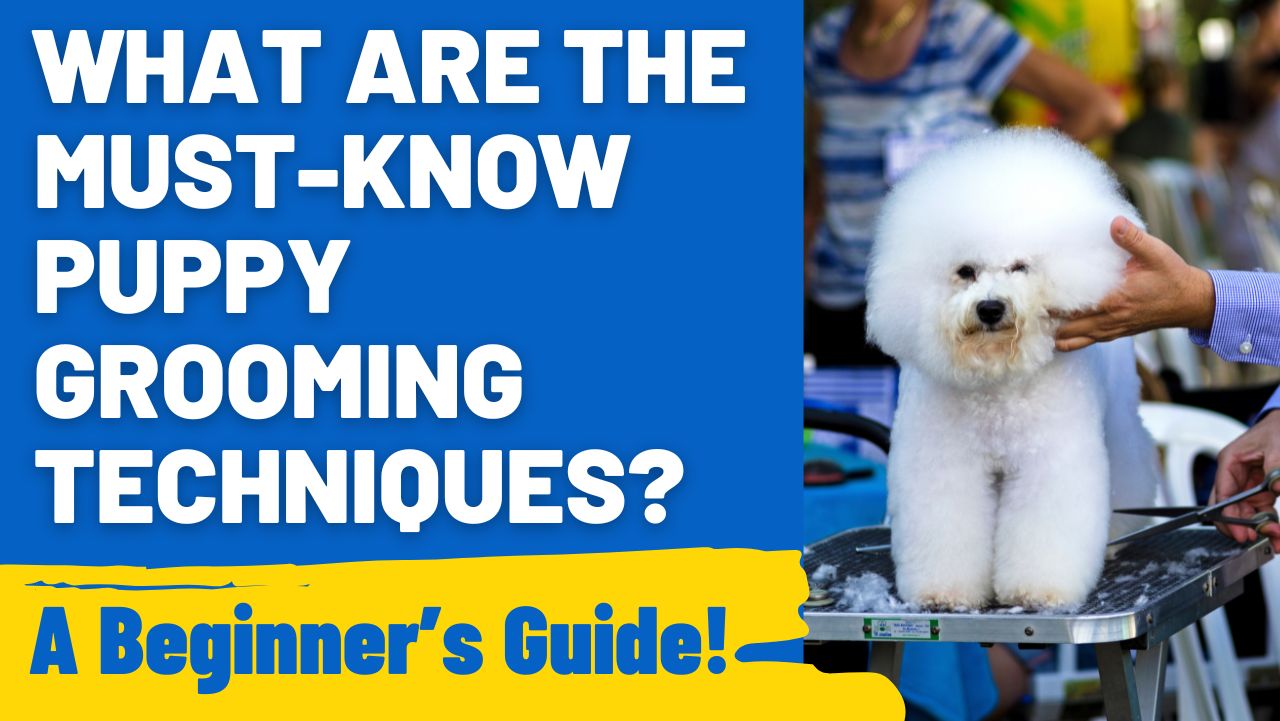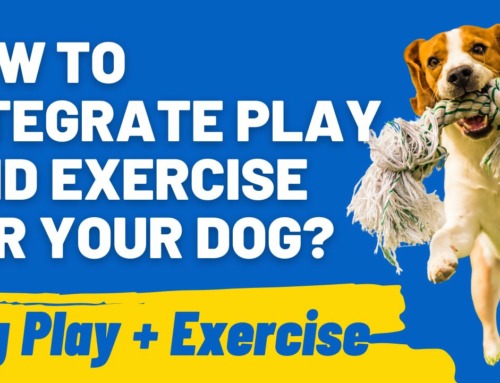Puppy grooming is an essential aspect of pet care that goes beyond keeping your furry friend looking adorable. It’s about maintaining their health, hygiene, and happiness.
For many pet owners, grooming a puppy can seem scary. The squirmy pups, the unfamiliar tools, and the fear of making a mistake – we’ve all been there.
But worry not! Grooming your puppy doesn’t have to be a struggle.
We’ll explore the must-know techniques that can transform grooming from a chore into an enjoyable bonding experience with your pup.
From brushing and bathing to nail trimming and ear care, we’ll cover all the basics. Let’s get started!
Why Is Grooming Essential for Your Puppy’s Health?

Grooming is far more than just a cosmetic procedure for your puppy; it’s a vital part of their health and well-being. Regular puppy grooming does wonders, from maintaining a healthy coat and skin to contributing to their overall happiness and socialization.
Firstly, grooming removes dirt and debris, preventing skin irritations and infections. Brushing helps distribute natural oils throughout their coat, keeping it shiny and healthy.
It’s also the perfect opportunity to check for fleas, ticks, or other parasites.
Beyond physical health, grooming plays a key role in your puppy’s mental well-being. It becomes a routine that your pup can expect and enjoy.
This regular, calm interaction helps build trust between you and your puppy. It’s a way to show them love and care, which strengthens your bond.
Socialization is another crucial aspect. Grooming sessions introduce your puppy to being handled.
This exposure is important for vet visits and interactions with others. They learn to be comfortable with touch, which is essential for a well-adjusted, sociable dog.
In short, puppy grooming is an integral part of your pet’s routine. It ensures they look good, feel good, and stay healthy, setting the stage for a happy, well-socialized dog.
What Does Grooming Do for a Puppy’s Coat and Skin?
Grooming plays a pivotal role in maintaining the health and beauty of a puppy’s coat and skin. It’s not just about looking good; it’s about keeping their largest organ – the skin – in top condition.
When it comes to puppy grooming, it’s all about regular maintenance and care.
Brushing is the cornerstone of coat care. It removes loose fur, dirt, and dander, preventing matting and tangling. This routine also stimulates blood flow to the skin, promoting a healthy, shiny coat.
For puppies, whose coats are still developing, regular brushing aids in the transition to their adult coat.
Grooming also helps in identifying any skin issues early on, such as dry patches, redness, or signs of infection.
Bathing with the right shampoo keeps their skin clean and hydrated, but it’s important not to overdo it, as too frequent baths can strip away natural oils.
Can Grooming Affect My Puppy’s Behavior?
Absolutely! Grooming has a significant impact on your puppy’s behavior, often in ways that many pet owners might not immediately realize.
Regular grooming sessions are not just about keeping your pup looking sharp; they’re an opportunity to strengthen your bond and instill a sense of calm and trust in your puppy.
During grooming, puppies learn to be handled gently and become accustomed to being touched. This experience is invaluable for reducing anxiety and increasing their comfort with human interaction.
The one-on-one attention during these sessions makes your puppy feel secure and loved, reinforcing a positive relationship between you both.
Interested in reading our post about Dog Grooming 101: Everything You Need to Know for Healthy Pet Maintenance!
What Are the Basic Grooming Techniques Every Puppy Parent Should Know?
Mastering puppy grooming is a key aspect of pet parenthood. It ensures your furry friend looks, feels, and behaves their best.
Let’s walk through some essential grooming techniques that every puppy parent should know.
These basics will keep your puppy in tip-top shape and make grooming sessions enjoyable for both of you.
Bathing Tips: How Often and How Best?
Bathing your puppy is more than just a cleanliness routine; it’s an integral part of grooming.
However, it’s important to find the right balance. Over-bathing can strip natural oils from their skin, leading to dryness and irritation.
Generally, bathing once a month is sufficient unless your puppy gets exceptionally dirty or smelly.
For a stress-free bath time:
- Use lukewarm water and a puppy-specific shampoo.
- Start by gently wetting your puppy, avoiding the eyes and ears.
- Lather the shampoo and gently massage it through their coat.
- Rinse thoroughly to avoid leaving any soap residue.
- Dry them with a soft towel or a low-heat hair dryer, ensuring they’re completely dry, especially in colder weather.
Remember, the first bathing experiences set the tone for future grooming, so keep it calm and pleasant.
Brushing Techniques: What’s the Right Way?
Brushing is crucial for all puppies, regardless of coat type. It removes dirt, dead hair, and prevents matting.
For short-haired breeds, a rubber brush or grooming mitt works well. For long-haired breeds, a slicker brush or pin brush is ideal.
Effective brushing tips include:
- Gently brush in the direction of hair growth.
- Be extra careful around sensitive areas like the face and paws.
- Regular brushing (at least a few times a week) helps reduce shedding and keeps the coat healthy.
Nail Trimming: How to Do It Safely?
Nail trimming is often daunting for new puppy parents, but it’s essential for your puppy’s comfort and mobility. Overgrown nails can cause pain and lead to posture problems.
To trim your puppy’s nails safely:
- Use a sharp, specially designed dog nail trimmer.
- Identify the quick (the pink area within the nail where blood vessels and nerves are), especially in light-colored nails.
- Trim just a small part of the nail at a time to avoid cutting the quick.
- If you accidentally cut the quick, don’t panic. Apply some styptic powder to stop the bleeding.
Always associate nail trimming with positive experiences. Start by handling their paws regularly to get them used to the sensation.
Ear Cleaning: Why and How?
Ear cleaning is a vital part of puppy grooming. Keeping your puppy’s ears clean is vital for preventing infections and ensuring their overall well-being.
Dogs with floppy ears are especially prone to ear issues, as their ear structure can trap moisture and debris, creating an ideal environment for bacteria and yeast.
How to Clean Your Puppy’s Ears:
- Use a vet-recommended ear cleaning solution.
- Apply the solution into the ear canal, then gently massage the base of the ear.
- Allow your puppy to shake their head, which helps loosen debris.
- Wipe away the loosened debris and wax from the outer ear with a cotton ball or soft cloth.
Why Clean Your Puppy’s Ears?
Regular ear cleaning helps to:
- Prevent ear infections.
- Remove built-up wax and debris.
- Identify any potential issues early, like mites or unusual discharge.
Regular grooming is more than just a beauty routine. It’s a health check, a bonding session, and a behavioral training opportunity all rolled into one.
What Tools Do You Need for Effective Puppy Grooming?
Effective puppy grooming is as much about the right techniques as it is about the right tools. Having the essential grooming tools at hand makes the process easier and more enjoyable for both you and your puppy.
Here’s a rundown of the must-have items in your puppy grooming toolkit:
Comparison of Different Grooming Tools
| Tool | Use | Recommendation for Puppy Fur Types |
| Slicker Brush | Detangling and smoothing | Long, curly or thick fur |
| Bristle Brush | Smoothing and shining | Short to medium, smooth coats |
| Pin Brush | Gentle detangling and smoothing | Medium to long fur |
| Nail Clippers | Trimming nails | All types |
| Nail Grinder | Smoothing nail edges | Nervous puppies or thick nails |
| Shampoo and Conditioner | Bathing | All types, choose according to skin sensitivity |
| Ear Cleaning Solution | Cleaning ears | All types, especially breeds prone to ear infections |
| Grooming Wipes | Quick cleanups | All types, especially for face and paws |
How to Create a Regular Grooming Routine for Your Puppy?
Establishing a regular grooming routine for your puppy is a crucial aspect of their overall care.
A consistent routine not only keeps your puppy looking great but also contributes to their health and well-being.
When creating a grooming schedule, consider your puppy’s age, breed, and coat type, as these factors determine the frequency and type of grooming needed.
When Should You Start Grooming Your Puppy?
The best time to start grooming practices is as soon as your puppy comes home. Young puppies are more open to new experiences, making it an ideal time to introduce grooming.
Start with short, gentle sessions, focusing on making it a positive experience.
You can gradually introduce brushing, followed by more involved tasks like nail trimming and bathing as they get used to the process.
For breeds with longer or more demanding coats, early grooming is essential to prevent matting and tangling.
For short-coated breeds, grooming can be more about skin care and general upkeep.
Developing a Grooming Schedule: What Works Best?
A grooming schedule should be tailored to fit both your puppy’s needs and your lifestyle. Here are some guidelines:
- Brushing:
- Short coats: Once a week is usually sufficient.
- Long or thick coats: Several times a week or even daily to prevent mats and tangles.
- Bathing:
- Bathe your puppy once a month or as needed. Overbathing can strip natural oils from their coat.
- Nail Trimming:
- Check your puppy’s nails every few weeks. The frequency of trimming depends on how fast their nails grow, which can be influenced by their level of activity.
- Ear Cleaning:
- This should be done monthly, especially for breeds prone to ear infections. Check the ears weekly for any signs of infection or irritation.
- Dental Care:
- Introduce teeth brushing early. Aim for several times a week.
- Paw Care:
- Check and clean paws regularly, especially after walks.
Remember, the key is consistency. Regular grooming not only keeps your puppy in top shape but also helps you spot any health issues early.
Additionally, a routine helps your puppy understand that grooming is a normal part of their life, which can reduce anxiety and make the process smoother.
Advanced Grooming Techniques: Should You Consider Them?
As you become more comfortable with the basics of puppy grooming, you might wonder about stepping up your game with some advanced techniques.
Advanced grooming can include anything from breed-specific haircuts to intricate nail art.
But the question is, are these advanced techniques necessary for your puppy, and when should you consider professional help?
Advanced grooming techniques are often more about aesthetics than health.
For certain breeds, like Poodles or Shih Tzus, keeping up with their traditional haircuts can be a part of maintaining their breed’s standard appearance.
In these cases, it might be beneficial to learn advanced grooming skills or seek the help of a professional groomer.
However, for the average pet owner, sticking to the basics is usually sufficient. Over-grooming or trying complex techniques without proper training can potentially harm your puppy.
Techniques like close shaving, intricate styling, or even dyeing a puppy’s fur, if done incorrectly, can lead to skin irritation or other issues.
Professional groomers are trained to handle advanced grooming safely. They have the right tools and knowledge about different breed standards and skin and coat needs.
If you’re interested in advanced grooming for aesthetic reasons or due to the requirements of your puppy’s breed, it’s often best to leave it to the professionals. This ensures your puppy gets the look you want without any risk to their well-being.
When to Seek Professional Grooming Help?
Knowing when to seek professional grooming help is an important part of puppy grooming.
While many aspects of grooming can be handled at home, certain situations call for a professional’s touch.
If your puppy has a particularly difficult coat type that’s prone to matting or requires specialized care, a professional groomer can be invaluable.
Additionally, if you’re unsure about how to safely trim nails or clean ears, or if your puppy gets anxious during grooming, a professional can ensure these tasks are done safely and with minimal stress.
Conclusion
Embracing grooming as a regular activity can transform it into a wonderful bonding experience for you and your puppy.
Through consistent grooming, you not only ensure your puppy looks and feels great but also deepen the connection between you. Regular grooming checks can also be crucial in spotting any health issues early on.
So, grab your brushes, combs, and clippers, and enjoy the journey of keeping your furry friend well-groomed and healthy.
Remember, for more insights and tips on puppy care, be sure to check out HoundGames!




